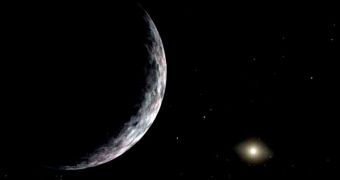According to a new astronomical study, it may be that the long-held belief that Eris is larger than Pluto is false. Data would now appear to suggest that Pluto is indeed larger than its Kuiper Belt “colleague.”
For many years, astronomers have believed that the dwarf planet Eris was the largest body beyond the orbit of the gas giant Neptune. This is where the outer asteroid belt, also called the Kuiper Belt, begins.
The formation contains thousands upon thousands of space bodies, including asteroids, meteorites, comets and dwarf planets. Eris, Pluto, Haumea, and Makemake are just some of the largest bodies that orbit in the Belt.
Previous investigations suggested that, though much farther from the Sun than Pluto, Eris was a lot larger. But a recent investigation appears to contradict those conclusions, showing that Pluto is indeed the larger body.
The new measurements indicate that Eris has a diameter of no more than 1,454 miles (2,340 kilometers), whereas its direct “competitor” is 66 percent the size of the Moon, at 2,306 kilometers.
Over this weekend, three separate groups of astronomers observed a phenomenon called an occultation, during which Eris passed in front of a distant star, as viewed from Earth. The experts seized this opportunity to find out more about the dwarf planet.
Using their telescopes, they were able to calculate Eris' diameter with greater precision than ever before, an article in the magazine Sky & Telescope indicates. What is interesting about the new study is the implications it has for astronomy.
Scientists know for a fact that Eris is about 25 percent heavier than Pluto. If the dwarf planet is so massive, then surely it must be more dense, which means that it is made up of different materials than Pluto. Astronomers were surprised to arrive at this conclusion.
“The fact that their densities are so different is totally unexpected. Eris is no longer a Pluto twin. It's an entirely different object,” says California Institute of Technology astronomer Mike Brown. The expert discovered Eris back in 2005, but was not involved in the new measurements.
Paris Observatory expert Bruno Sicardy coordinated the international effort to observe Eris during the occultation event, which was carried out by dozens of astronomers at numerous locations.
Scientists are still rummaging through the data, and they say that some time will pass until they will be able to say for sure why these large differences exist between the two Kuiper Belt objects, Space reports.

 14 DAY TRIAL //
14 DAY TRIAL //